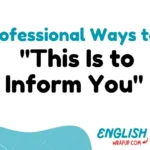Idioms are the heartbeat of language, bringing vibrancy and nuance to everyday communication. They often convey meanings that go beyond the literal interpretation of words, adding depth and richness to our expressions.
One commonly used phrase is “This shows,” a simple way to point out evidence or illustrate a point. However, there are many other idiomatic expressions that can serve the same purpose, each bringing its own unique flavor to the conversation.
In this article, we’ll explore 25 different ways to say “This shows,” enhancing your linguistic repertoire and making your communication more engaging and precise.
Is It Professional To Say “This Shows”
Yes, using “this shows” can be professional, especially when presenting findings, results, or evidence in a clear and direct manner.
For example, in a report or presentation, you might say, “This shows that our marketing strategy is effective.”
It concisely highlights the connection between the data or evidence and the conclusion.
List Of 25 Other Ways to Say “This Shows”
- This demonstrates
- This indicates
- This reveals
- This illustrates
- This highlights
- This exemplifies
- This signifies
- This suggests
- This portrays
- This underscores
- This conveys
- This proves
- This reflects
- This manifests
- This implies
- This confirms
- This attests
- This points out
- This depicts
- This substantiates
- This evidences
- This signifies
- This establishes
- This validates
- This corroborates
1. This demonstrates
“This demonstrates” is used to provide a clear example or proof of something. It’s often employed in formal settings to emphasize evidence or findings.
Example: The data clearly demonstrates the effectiveness of the new marketing strategy.
2. This indicates
“This indicates” suggests that something points to a particular conclusion or understanding. It’s suitable for both formal and informal contexts.
Example: The rise in temperatures indicates a shift in climate patterns.
3. This reveals
“This reveals” uncovers or makes known something that was previously hidden or unclear. It is often used in investigative or analytical contexts.
Example: The report reveals significant discrepancies in the financial records.
4. This illustrates
“This illustrates” provides a visual or clear example of a point being made. It’s commonly used in educational or explanatory contexts.
Example: The chart illustrates the growth of the company over the past five years.
5. This highlights
“This highlights” draws attention to a particular point or aspect, emphasizing its importance. It is frequently used in both formal and informal discussions.
Example: The incident highlights the need for better safety protocols.
6. This exemplifies
“This exemplifies” serves as a perfect example of a particular quality or type. It’s often used in academic or detailed explanations.
Example: Her dedication to the project exemplifies the kind of commitment we value in our team.
7. This signifies
“This signifies” means that something represents or stands for something else. It is typically used in formal contexts.
Example: The award signifies recognition of his hard work and achievements.
8. This suggests
“This suggests” implies or hints at a particular idea or conclusion. It is suitable for both formal and informal communication.
Example: The survey results suggest that customer satisfaction is on the rise.
Read Also: Other Ways to Say “Please Disregard My Previous Email”
9. This portrays
“This portrays” depicts or describes something in a particular way. It’s often used in literary or descriptive contexts.
Example: The novel portrays the struggles of the working class in the 19th century.
10. This underscores
“This underscores” emphasizes the importance or significance of something. It’s typically used in formal discussions.
Example: The recent events underscore the need for reform in the healthcare system.
11. This conveys
“This conveys” communicates or expresses a particular idea or feeling. It is used in both formal and informal contexts.
Example: Her speech conveys a sense of urgency about the environmental crisis.
12. This proves
“This proves” provides conclusive evidence of something. It is often used in logical or analytical contexts.
Example: The experiment proves the hypothesis beyond any doubt.
13. This reflects
“This reflects” shows or indicates the existence of something. It’s commonly used in both formal and informal discussions.
Example: His attitude reflects his upbringing and personal values.
14. This manifests
“This manifests” shows something clearly through appearance or demonstration. It’s used in formal contexts.
Example: The symptoms manifest themselves within a few hours of exposure.
15. This implies
“This implies” suggests something without directly stating it. It is suitable for both formal and informal communication.
Example: His silence implies that he agrees with the decision.
16. This confirms
“This confirms” verifies the truth or correctness of something. It’s used in formal contexts.
Example: The findings confirm our initial suspicions.
Read Also: Other Ways to Say “It Was a Pleasure Speaking With You”
17. This attests
“This attests” provides evidence or proof of something. It is typically used in formal contexts.
Example: The certificate attests to his qualifications and expertise.
18. This points out
“This points out” highlights or draws attention to something. It’s used in both formal and informal contexts.
Example: She points out the flaws in the current system.
19. This depicts
“This depicts” shows or represents something in a particular way. It is often used in artistic or descriptive contexts.
Example: The painting depicts a serene landscape at sunset.
20. This substantiates
“This substantiates” provides evidence to support or prove something. It’s typically used in formal contexts.
Example: The documents substantiate his claims of ownership.
21. This evidences
“This evidences” provides proof or evidence of something. It is commonly used in formal contexts.
Example: The contract evidences the agreement between the two parties.
22. This signifies
“This signifies” indicates or symbolizes something. It’s used in formal contexts.
Example: The red flag signifies danger ahead.
23. This establishes
“This establishes” proves or confirms the validity of something. It is typically used in formal discussions.
Example: The research establishes a clear link between diet and health.
24. This validates
“This validates” confirms the truth or accuracy of something. It is used in both formal and informal contexts.
Example: The test results validate the effectiveness of the new drug.
Read Also: Formal Ways to Say “Talk to You Soon”
25. This corroborates
“This corroborates” supports or confirms something with additional evidence. It’s commonly used in formal contexts.
Example: The witness’s testimony corroborates the defendant’s alibi.
Final Thoughts
Understanding and using idioms enrich our language and enhance our communication skills. Idioms like those listed above offer varied ways to express similar ideas, allowing us to communicate more effectively and dynamically.
By incorporating these expressions into our vocabulary, we can convey our thoughts with greater precision and impact, making our interactions more engaging and meaningful.

I’m Olivia Martinez, the educational mind behind “English WRAP Up.” I’ve had a blast teaching and grading English tests like TOEFL, IELTS, BULATS, FCE, CAE, and PTEG. At English WRAP Up, we’re dedicated to turning your exam preparation into a success story. Let’s make your English skills shine—join me in the educational journey at English WRAP Up!



